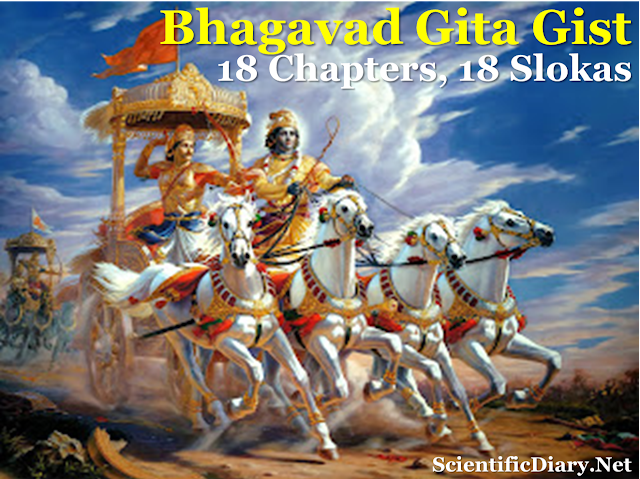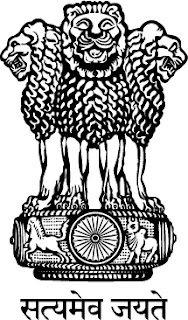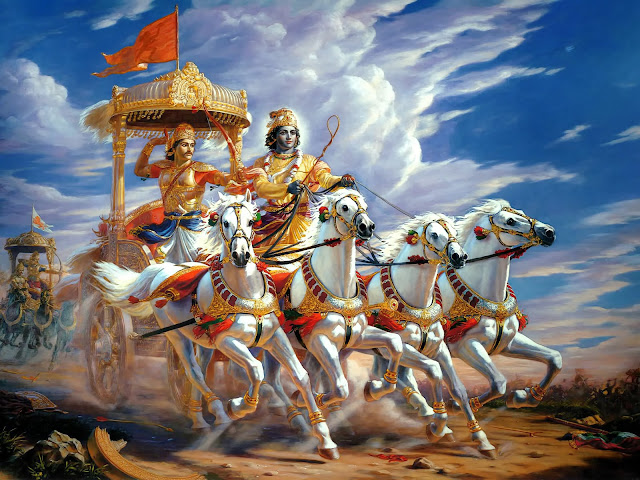Bhagavad Gita Gist: 18 important slokas (verses) from 18 chapters
The Bhagavad Gita, sacred scripture, a part of the Mahabharata, contains dialogue between Lord Krishna and Pandava Prince Arjuna, providing profound spiritual and management teachings. It addresses the path to self-realization, duty (dharma), and devotion, emphasizing the importance of performing one's duties with detachment and surrender to the divine for attaining inner peace and liberation (moksha) from the cycle of death and rebirth. The teachings of the Bhagavad Gita took place on the battlefield of Kurukshetra, an ancient battlefield in present-day Haryana, India. Kurukshetra is a historically significant location where the great war between the Pandavas (led by Arjuna) and the Kauravas (led by Duryodhana) is set to take place. Let us summarise Bhagavad Gita through 18 most important slokas from 18 chapters.
Chapter 1
Chapter 1, Verse 1
“dhṛtarāṣṭra uvāca
dharma-kṣetre kuru-kṣetre
samavetā yuyutsavaḥ
māmakāḥ pāṇḍavāś caiva
kim akurvata sañjaya”
"Dhritarashtra said: O Sanjaya, assembled in the holy land of Kurukshetra and desiring to fight, what did my sons and the sons of Pandu do?"
This verse sets the stage for the entire dialogue of the Bhagavad Gita, as it introduces the context of the Kurukshetra battlefield and the desire for battle among the warriors. It is often cited as the beginning of the Gita's narrative.
Chapter 2
Chapter 2, Verse 47
"karmaṇy evādhikāras te
mā phaleṣu kadācana
mā karma-phala-hetur bhūr
mā te saṅgo ’stv akarmaṇi"
"You have a right to perform your prescribed duties, but you are not entitled to the fruits of your actions. Never consider yourself the cause of the results of your activities, and never be attached to not doing your duty."
This verse emphasizes the importance of performing one's duties without attachment to the outcomes and encourages selfless action. It is a central teaching of the Bhagavad Gita and is often cited to convey the concept of performing one's responsibilities with detachment from the results.
Chapter 3
Chapter 3, Verse 21
"yad yad ācarati śreṣṭhas
tat tad evetaro janaḥ
sa yat pramāṇaṁ kurute
lokas tad anuvartate"
"Whatever a great man does, common men will follow in his footsteps. And whatever standards he sets by exemplary acts, all the world pursues."
This verse emphasizes the influential role of leaders and role models in society. It suggests that people tend to follow the behaviour and standards set by respected individuals. It is often quoted to underscore the importance of setting a positive example through one's actions and behaviour.
Chapter 4
Chapter 4, Verse 7
"yadā yadā hi dharmasya glānir bhavati bhārata
abhyutthānam adharmasya tadātmānaḿ sṛijāmy aham"
"Whenever and wherever there is a decline in righteousness and an increase in unrighteousness, O descendant of Bharata, at that time I manifest myself."
This verse is significant because it highlights Lord Krishna's divine incarnations (avatars) and how they appear whenever there is a decline in righteousness and a rise in unrighteousness to restore balance and dharma (righteousness) in the world. It underscores the concept of divine intervention for the preservation of dharma and is often cited in discussions of Lord Krishna's role in the Gita.
Chapter 5
Chapter 5, Verse 2
"śrī-bhagavān uvāca
karma-sannyāsaḥ karma-yogo
yaḥ karma-bandhanaḿ prahuḥ
yas tyāgī ca yaḥ samnyāsī
sa yo'vabhicchāṇaḥ sannyāsī"
"The Supreme Personality of Godhead said: The renunciation of work and work in devotion are both good for liberation. But, of the two, work in devotional service is better than renunciation of work."
This verse emphasizes the importance of selfless and devotional work as a means to attain liberation. It suggests that engaging in one's duties with devotion and without attachment is a superior path to spiritual growth compared to renouncing work altogether.
Chapter 6
Chapter 6, Verse 17
"yuktāhāra-vihārasya
yukta-ceṣṭasya karmasu
yukta-svapnāvabodhasya
yogo bhavati duḥkha-hā”
"He who is disciplined in his habits of eating, sleeping, recreation and work can lessen all material pains by practicing the yoga system."
In this verse, Lord Krishna is teaching the importance of moderation in various aspects of life as a means to achieve a state of Yoga, which is often understood as a state of union with the Divine. In the Bhagavad Gita, ‘yoga’ is not only to physical postures and exercises but deals with a broader and more profound meaning., Lord Krishna imparts teachings on various paths of yoga, emphasizing the importance of spiritual development and self-realization.
Chapter 7
Chapter 7, Verse 14
"daivī hy eṣā guṇa-mayī
mama māyā duratyayā
mām eva ye prapadyante
māyām etāṁ taranti te"
"This divine energy of Mine, consisting of the three modes of material nature, is difficult to overcome. But those who have surrendered unto Me can easily cross beyond it."
In this verse, Lord Krishna explains the power of His divine energy, which is associated with the three modes of material nature (sattva, rajas, and tamas). He emphasizes that those who surrender to Him with devotion can transcend this material energy and attain spiritual liberation. This verse underscores the importance of surrender and devotion as a means to overcome the material world and attain union with the divine.
Chapter 8
Chapter 8, Verse 5
"anta-kāle ca mām eva
smaran muktvā kalevaram
yaḥ prayāti sa mad-bhāvaṁ
yāti nāsty atra saṁśayaḥ"
"And whoever, at the time of death, quits his body, remembering Me alone, at once attains My nature. Of this, there is no doubt."
This verse emphasizes the importance of remembering Lord Krishna with devotion at the time of death as a means to attain liberation and merge with the divine. It underscores the significance of one's consciousness and thoughts during the final moments of life.
Chapter 9
Chapter 9, Verse 34
"man-manā bhava mad-bhakto
mad-yājī māṁ namaskuru
mām evaiṣyasi yuktvaivam
ātmānaṁ mat-parāyaṇaḥ"
"Engage your mind always in thinking of Me, offer respect and worship Me. Being completely absorbed in Me, surely you will come to Me."
In this verse, Lord Krishna emphasizes the importance of devotion and single-minded focus on Him as a means to attain spiritual realization and ultimately reach Him. It encourages the practice of constant remembrance, worship, and surrender to the divine as a way to achieve a close and loving relationship with the Lord.
Chapter 10
Chapter 10, Verse 2
" na me viduḥ sura-gaṇāḥ
prabhavaṁ na maharṣayaḥ
aham ādir hi devānāṁ
maharṣīṇāṁ ca sarvaśaḥ "
"I am the source of all the devas (celestial beings) and the great sages. There is no one greater than Me. O Arjuna, all the offerings and sacrifices ultimately come to Me."
In this verse, Lord Krishna asserts His divine supremacy as the ultimate source of all celestial beings and sages and highlights that all offerings and sacrifices are ultimately meant for Him. It underscores the concept of God as the supreme reality and the recipient of all devotion and worship. This verse is often cited to emphasize the all-encompassing nature of the divine.
Chapter 11
Chapter 11, Verse 38
"tvam ādi-devaḥ puruṣhaḥ purāṇas
tvam asya viśhvasya paraṁ nidhānam
vettāsi vedyaṁ cha paraṁ cha dhāma
tvayā tataṁ viśhvam ananta-rūpa"
"O Supreme Lord, You are the original personality, the Supreme Abode, and the ultimate sanctuary of this manifested cosmic world. You are the knower, the object of knowledge, and the supreme destination. By You, this all is pervaded, O infinite form."
These verses highlight Lord Krishna's omnipotence and his status as the Supreme Being in Hinduism, who encompasses all aspects of creation, knowledge, and existence.
Chapter 12
Chapter 12, Verse 8
" mayy eva mana ādhatsva
mayi buddhiṁ niveśaya
nivasiṣyasi mayy eva
ata ūrdhvaṁ na saṁśayaḥ "
"Just fix your mind upon Me, the Supreme Personality of Godhead, and engage all your intelligence in Me. Thus you will live in Me always, without a doubt."
This verse emphasizes the path of devotion and surrender to the Supreme Lord. It encourages individuals to focus their minds and intelligence on God, cultivating unwavering faith and devotion. By doing so, one can attain a state of being constantly absorbed in the divine and living in unity with the Lord.
Chapter 13
Chapter 13, Verse 13
"jñeyaṁ yat tat pravakṣyāmi
yaj jñātvāmṛtam aśnute
anādi mat-paraṁ brahma
na sat tan nāsad ucyate"
"I shall now explain that which is to be known, knowing which one attains immortality. The supreme, eternal Brahman is without beginning; it is said to be neither existence nor non-existence."
Lord Krishna is explaining a profound and eternal truth (Brahman) that, when known, leads to immortality. This truth is described as beyond the concepts of existence and non-existence and is without a beginning. It is a fundamental concept in Hindu philosophy, emphasizing the transcendental and eternal nature of the ultimate reality (Brahman).
Chapter 14
Chapter 14, Verse 26
"māṁ ca yo ’vyabhicāreṇa
bhakti-yogena sevate
sa guṇān samatītyaitān
brahma-bhūyāya kalpate"
"One who engages in full devotional service, who does not fall down in any circumstance, at once transcends the modes of material nature and thus comes to the level of Brahman."
This verse highlights the significance of unwavering devotion and service to the Supreme as a means to transcend the influence of the modes of material nature and attain the state of realization and oneness with the divine, often referred to as "Brahman realization." It emphasizes the power of steadfast devotion in spiritual progress, which is a central theme of this chapter.
Chapter 15
Chapter 15, Verse 15
"vedaiśh cha sarvair aham eva vedyo
vedānta-kṛid veda-vid eva chāham"
"I am to be known by all the Vedas; I am the compiler of Vedanta, and I am the knower of the Vedas."
In this verse, Lord Krishna asserts His supreme position as the ultimate subject of study and realization in the Vedas. He is the essence of all Vedic knowledge, the compiler of Vedanta (the end portion of the Vedas), and the ultimate knower of the Vedas. This verse highlights the central role of Lord Krishna in Vedic wisdom and knowledge and underscores His divinity as the source of all spiritual understanding.
Chapter 16
Chapter 16, Verse 6
"dvau bhūta-sargau loke'shmin
daiva āsura eva cha
daivo vistaraśhaḥ prokta
āsuraḥ pārtha me śhṛiṇu"
"O son of Pritha, in this world there are two kinds of created beings. One is called the divine and the other demoniac. I have already explained to you at length the divine qualities. Now hear from Me of the demoniac."
In this verse, Lord Krishna distinguishes between two types of beings: those with divine qualities and those with demoniac qualities, similar to the distinction made in Chapter 14. He mentions that He has already explained the divine qualities and is now going to describe the demoniac qualities. This verse sets the stage for a discussion on the contrasting nature of these qualities and their impact on human behaviour and spiritual progress, which is a central theme of this chapter.
Chapter 17
Chapter 17, Verse 17
"śhraddhayā parayā taptam
tapas tat tri-vidham naraiḥ
aphalākāṅkṣhibhir yuktaiḥ
sāttvikam parichakṣhate"
"That attitude which is practiced with the utmost faith by men who do not desire the fruits, who are self-restrained and are of a pure mind, that is declared to be in the mode of goodness (balanced)."
In this verse, Lord Krishna describes the nature of attitude (tapas) performed in the mode of goodness (sattva). It highlights the importance of practicing austerity with unwavering faith, without desiring material rewards, and with self-restraint and a pure mind. Such attitude is considered to be in the mode of goodness and is often cited to emphasize the purity of intention and self-discipline required in spiritual practices.
Chapter 18
Chapter 18, Verse 24
"yat tu kāmepsuṇā karma
sāhaṅkāreṇa vā punaḥ
kriyate bahulāya sādhyā
tat rājasam udāhṛitam"
"But action that is done with great effort by one seeking to gratify desires, and is enacted with pride and arrogance/ egoism, and without taking into account any adverse consequences, is to be labeled rajasic (passionate)."
In this verse, Lord Krishna describes actions performed with a strong desire for personal gratification, pride, and arrogance as rajasic (passionate) in nature. It underscores the idea that actions driven by ego and selfish desires are of a lower quality and are often cited to highlight the distinction between actions done with pure intention and those done with selfish motives.
Reference
[1] Unknown facts about Bhagavad Gita
[2] Chapter wise summary Bhagavad Gita
[3] Bhagavad Gita As it is by A. C. Bhaktivedanta Swami Prabhupada





























Comments
Post a Comment